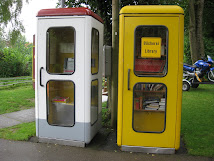This is a translation of the column I'm writing for Danish industry publication Markedsføring (Marketing).
Music and Branding deals with the trinity of brands, bands, and fans. It looks at how brands use (or don't use) music as part of their brand management and marketing efforts and how bands collaborate with brands.
This column (no. 3) was published in issue #11 Sept 28th, 2010 and focuses on the importance of having a clear purpose for the use of music as part of the overall brand framework and a strategy for fulfilling that purpose (column no. 1 and 2 is here and here).
In the previous column (issue 9 of the magazine) we looked at how music influences our emotions and physical well-being as well as encourages social interaction. We established that music provides a variety of options for strengthening the emotional relationship between brand and consumer. And we concluded that this is the reason why brand managers must decide and define the role - big or small - that music should be playing within the overall brand strategy.
Eliminate the danger of too many options
Music is both media and content. Music delivers the broadest array of touch points than any other entertainment category and is hands down the most-consumed category across the board. So the opportunities for both reach and engagement are almost countless.
Exactly this fragmentation increases the risk of grasping at these opportunities arbitrarily. The best case scenario of which is an incoherent experience. This way, we obviously don't leverage the potential of music to build the emotional bond to the consumer, nor to deliver ROI.
So in order to achieve the desired return, we need to take a more considered approach. Just like we have a portfolio strategy, product strategy, distribution strategy, pricing strategy, marcoms strategy etc as parts of the overall brand strategy, we need to define the music strategy. And how do we do that - what is a music strategy?
Music strategy 101
The elements of a music strategy are the same elements as in any other strategy:
It's about relevance, not what we personally like
As you can see we do not start by saying 'What kinda music do I like'. Neither with musical genres although most people intuitively start there by saying that the brand is 'jazzy', 'hiphop-y' or 'rock-ish'.
Brands are not defined this way, rather by values like 'safe', 'modern' or 'edgy'. Hence, the brand values are usually best expressed across genres. Danish fashion label Noir are consciously using classical as well as German 70s soul in their shows.
The values match is essential for a music strategy but it's only one out of a number of key components and must never be defined on the basis of personal preferences.
Start with the music profile
We cannot and should not all be Starbucks, Apple or Levi's who have invested many years and $$ in their music association. A practical place to start is by establishing a music profile (step 2 on the music staircase, see column 1).
When we have that in place, we have the creative framework for all subsequent activities and media in which music will be used.
A music profile is the sound dimension of the brand, just like a graphic profile (aka visual identity) is the visual dimension. A music profile defines the unique tone of the brand and is used in all touch points where sound plays a role, eg TV/radio/online ads, stores, showrooms, website, presentations, and IVR/waiting tune.
In addition, a music profile defines each component of the total profile (eg sound logo, 'tag music', riffs or other specifics parts/fragments, number and types of music pieces, sound scape), the hierarchy between these components, and where the profile and each component is to be used and not used.
There's plenty reason to spend some time defining the brand's music profile - remember that brands with music that matches their identity boast 96% higher recall rates than brands with mismatching or no music.
In the next column we will look at the state of the nation as far as brands' use of music as brand building tool is concerned, and their dedication to making it a success. No doubt, brands love music as much as consumers. But are they dedicating enough energy to make the love grow?
Previous columns:
Column #1
Column #2
skip to main |
skip to sidebar

A phone booth in Germany - with a library (bücherei) next door. Maybe if you get bored while on the phone... I don't know.
Stuff about stuff
What's going on here?
This is my personal blog about, oh I dunno, random stuff.
My food blog in Danish is here: www.madpåslump.dk.
Categories
- Brand (33)
- Business (29)
- Communication (25)
- Design (8)
- Exercise (1)
- Film (1)
- Human nature (10)
- Innovation (14)
- Leadership (22)
- Marketing (32)
- Music (20)
Search
Top quotes
I am always ready to learn, although I do not always like being taught (Churchill)
If you want to grow, surround yourself with brilliant people. (Henry Ford, I think)
Top inspirations
Peter Drucker
Steve Jobs
Richard Rumelt
The Beatles
Donald Duck
My cat
Top reads
- Jason Fried and David Hansson: Rework
- John Grant: After Image
- Graham Marsh and Paul Trynka: Denim from Cowboys to Catwalks
- Pearce Marchbank: The Illustrated Rock Almanac
- Margo Jefferson: On Michael Jackson
- Mark Hertsgaard: The Beatles
- Anthony Kiedis: Scar Tissue
Twitter updates
Photo du jour
A phone booth in Germany - with a library (bücherei) next door. Maybe if you get bored while on the phone... I don't know.



